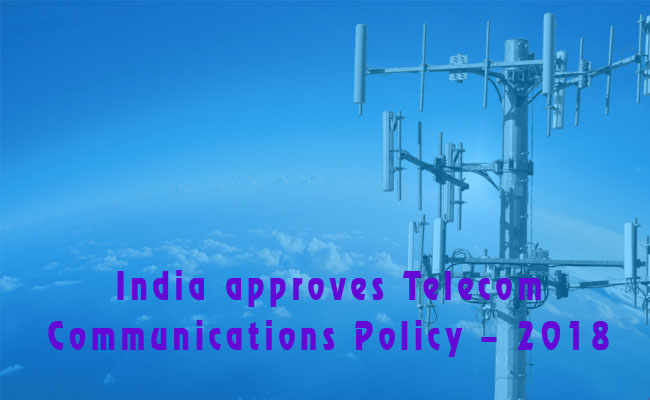India approves Telecom Communications Policy – 2018
By MYBRANDBOOK

India Government has approved the National Telecom Communications Policy – 2018 with the aim of ensuring broadband at 50 Mbps speed to 1.2 billion plus population, and 1 Gbps Internet to all Gram Panchayats. It will attract $100 billion investments and will create 4 mn jobs.
The Union Cabinet chaired by Prime Minister Narendra Modi has approved the National Digital Communications Policy-2018 and re-designation of the Telecom Commission as the Digital Communications Commission.
“Emerging technologies like 5G and Internet of Things warrant the need for a new consumer-centric and application-centric policy. The government aims to improve the reach of telecom services and applications riding on the network,” Sinha said. The last telecom policy was announced in 2012. The government aims to provide 50 mbps broadband to all key development institutions and improve connectivity in uncovered areas under the new policy.
The Department of Telecommunications (DoT) had on 1 May floated the draft for public consultation which has outlined goals the government wants to achieve by 2022, such as providing broadband coverage for all, creating 4 million additional jobs in the digital communications sector, apart from enhancing the contribution of the digital communications sector to 8% of India’s gross domestic product from less than 6% in 2017.
The customer focused and application driven NDCP-2018 will lead to innovations, after the launch of advanced technology such as 5G, IOT, M2M, etc. In order to attract investments of $100 billion in the digital communications sector and increase India’s contribution to global value chain, the government will review levies and fees, including licence fee, universal service obligation fund (USOF) levy and concept of pass-through revenues in line with principles of input line credit, apart from looking at rationalising spectrum usage charges.
Objectives
# 5 million public Wi-Fi Hotspots by 2020 and 10 million by 2022 through a National Broadband Mission
# Implementing a ‘Fibre First Initiative’ to take fibre to the home and broadband to all.
# The government also aims to enable infrastructure convergence for IT, telecom and broadcasting .
# 8% GDP contribution from ~ 6% in 2017
# Become top 50 nations in ICT Development Index of ITU from 134 in 2017
# 1 Gbps connectivity to all Gram Panchayats by 2020 and 10 Gbps by 2022
# Connectivity to all uncovered areas
# Train one million manpower
# Expand IoT ecosystem to 5 billion connected devices
# Establish a data protection regime for digital communications
India will be setting up a National Digital Grid by creating a National Fibre Authority. It will be establishing Common Service Ducts and utility corridors in all new city and highway road projects.
After Cabinet approval, the policy will be tabled in Parliament and an institutional mechanism will be set up to keep track of the implementation of the policy.


Legal Battle Over IT Act Intensifies Amid Musk’s India Plans
The outcome of the legal dispute between X Corp and the Indian government c...

Wipro inks 10-year deal with Phoenix Group's ReAssure UK worth
The agreement, executed through Wipro and its 100% subsidiary,...

Centre announces that DPDP Rules nearing Finalisation by April
The government seeks to refine the rules for robust data protection, ensuri...

Home Ministry cracks down on PoS agents in digital arrest scam
Digital arrest scams are a growing cybercrime where victims are coerced or ...


Icons Of India : PRATIVA MOHAPATRA
Prativa is a transformational leader with an incredible breadth of exp...

Icons Of India : Arundhati Bhattacharya
Arundhati Bhattacharya serves as the Chairperson and CEO of Salesforce...

ICONS OF INDIA : RITESH AGARWAL
Ritesh Agarwal is an Indian billionaire entrepreneur and the founder a...


IOCL - Indian Oil Corporation Ltd.
IOCL is India’s largest oil refining and marketing company ...

IREDA - Indian Renewable Energy Development Agency Limited
IREDA is a specialized financial institution in India that facilitates...

C-DAC - Centre for Development of Advanced Computing
C-DAC is uniquely positioned in the field of advanced computing...


Indian Tech Talent Excelling The Tech World - JAY CHAUDHRY, CEO – Zscaler
Jay Chaudhry, an Indian-American technology entrepreneur, is the CEO a...

Indian Tech Talent Excelling The Tech World - Anirudh Devgan , President, Cadence Design
Anirudh Devgan, the Global President and CEO of Cadence Design Systems...

Indian Tech Talent Excelling The Tech World - RAVI KUMAR S, CEO- Cognizant
Ravi Kumar S, appointed as CEO of Cognizant in January 2023, sets the ...
 of images belongs to the respective copyright holders
of images belongs to the respective copyright holders